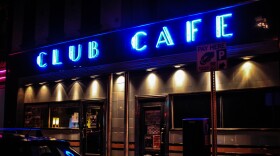In Pittsburgh’s Oakland neighborhood, there’s a massive temple to science. For nearly a century, the Mellon Institute has been a top research facility, helping to study air quality, create skinless hotdogs and even frozen orange juice.
The institution was first imagined by brothers Andrew and Richard Mellon in the early 1900s, inspired by a young chemistry professor named Robert Kennedy Duncan. As the United States’ economy — and especially Pittsburgh — became increasingly reliant on manufacturing, Duncan started creating fellowships for scientists who wanted to make an impact and improve upon the way these industries functioned.
“Applied science, not theoretical science,” said Paul Tellers, an architect who spent many years with Carnegie Mellon University, where he became familiar with the Mellon Institute’s history. “The Mellon brothers wanted to put their money on industrial development and they thought the way Duncan was doing it — with these fellowships — was a really good idea.”
After meeting in 1910, Duncan and the Mellons started the Industrial Fellowship Program through the University of Pittsburgh at a temporary laboratory at Thackeray and O’Hara Streets. According to a 1994/95 edition of “Pittsburgh History” by Cathy Wilson called “Building a Temple of Science: Pittsburgh’s Mellon Institute,” scientists were recruited to work on contracts. During that time, they’d try to solve problems manufacturers were encountering, be it in their workflow or the technology they were using.

The program was a success. In the years following, more and more research was commissioned and more and more scientists became interested in working at the Mellon Institute. It was incorporated as a nonprofit in 1927, and the Mellon brothers decided it was time to expand. They purchased a plot of land next to where the Cathedral of Learning was being constructed, and tapped Benno Jansen to be their architect.
“He did some amazing institutional architecture [including] the Pittsburgh Athletic Association, the Masonic Temple and the William Penn Hotel,” Tellers said.
The brothers wanted to make sure the building was state-of-the-art inside, and showed the grandeur of the operation on the outside. They decided to go with a Greek Parthenon model, specifically a peristyle-type building with 62 columns on all four sides.

“They had two big decisions to make early on,” Tellers said. “First, the building must be the most advanced scientific workshop that modern knowledge could provide. And then the second thing — you might think was almost in conflict with this: It must be beautiful as a tribute to science.”
With Grecian architectural roots nodding to the civilization’s historic scientific accomplishments and other nearby grand structures like the Carnegie Library, Museum of Natural History and Museum of Art, the Mellon Institute’s design would be in line with Oakland’s development at the time.
It’s a massive structure. “They built four floors below ground and four above that,” Tellers said. “Each column is 36.5 feet tall and nearly six feet in diameter at the bottom. They were quarried from 125 ton blocks of limestone brought from Indiana.”
Because of Andrew Mellon’s investment in the company that would later become Alcoa, aluminum was the primary metal used throughout the building.
“The many windows and doors and door hardware and you see the beautiful elevator doors are all beautifully crafted of aluminum to display Alcoa products,” said Tellers.

Inside, many laboratories were fitted with what was the most modern technology, but many labs were left empty, according to Emily Davis the collections archivist at Carnegie Mellon University Archives.
“They knew the institute would grow,” said Davis. “They also knew that the way science was conducted and what the laboratories needed to look like would evolve.”
Because of the contract-based work with industries in all fields, the work conducted at the Mellon Institute (which was actually called the Mellon Institute for Industrial Research until it was shortened to “Mellon Institute in 1962”) was varied. There was a focus on chemistry, physics, biology and engineering — and how they could tangibly help manufacturers, communities and even the U.S. military.
“Research that was taking place there included working with synthetic rubber for things like sleeping bag fill for the Navy or the Army,” Davis said.
The first gas mask used in World War I was developed at the Institute; researchers began studying the cause and impact of air pollution on Pittsburgh; and edible items like breakfast cereals, edible gelatins and beverage flavors were also developed there over the years. Until 2006, the Pittsburgh Supercomputing Center called Mellon Institute home.
Buried columns?
A local urban legend has suggested that an extra limestone column is buried in nearby land by the Cathedral of Learning. It’s one Davis herself admits to having been curious about, as well as several other Good Question! askers.
“The extra column mystery has been plaguing me since I started here,” Davis said. “If it was [buried], where?”
Unfortunately, there’s no documentation of this mystery column ever being buried. One extra column was created due to a defect in another, but there’s no indication it would have been buried or discarded in any sort of unusual way. According to Pitt history professor Thomas J. Morton, it was unlikely that they’d make any more than needed, because it was expensive and the transportation process from Indiana was challenging.
“The Mellon Institute was constructed in the middle of the Depression; it is HIGHLY unlikely that an ‘extra’ 36 foot column would simply be buried; that is a tremendous waste of materials — especially in the Depression,” Morton wrote in an email. “If an ‘extra’ column existed and was not needed, one could easily imagine it being recut in many ways and being repurposed for this Mellon building project or another one in the city.”
These days, you’ll still find research happening at the Mellon Institute. It showed up in Batman’s The Dark Knight Rises, which was shot in Pittsburgh in 2011. But often if you pass by, you’ll see it being used as the backdrop for prom, graduation or wedding photos.














